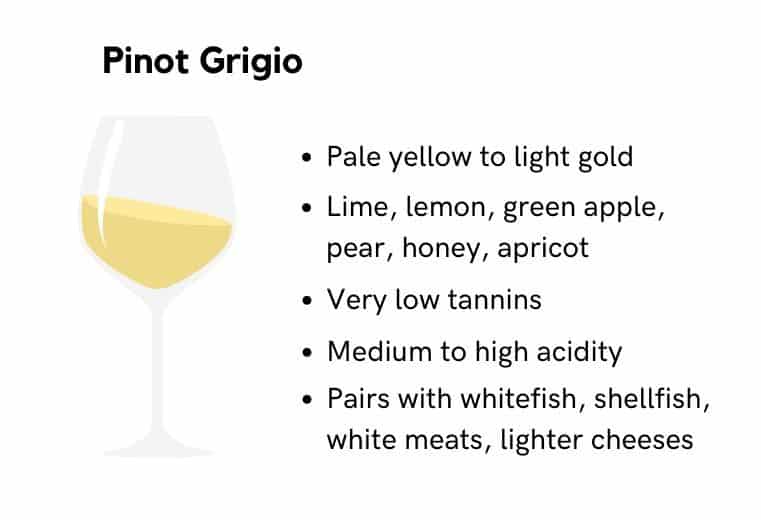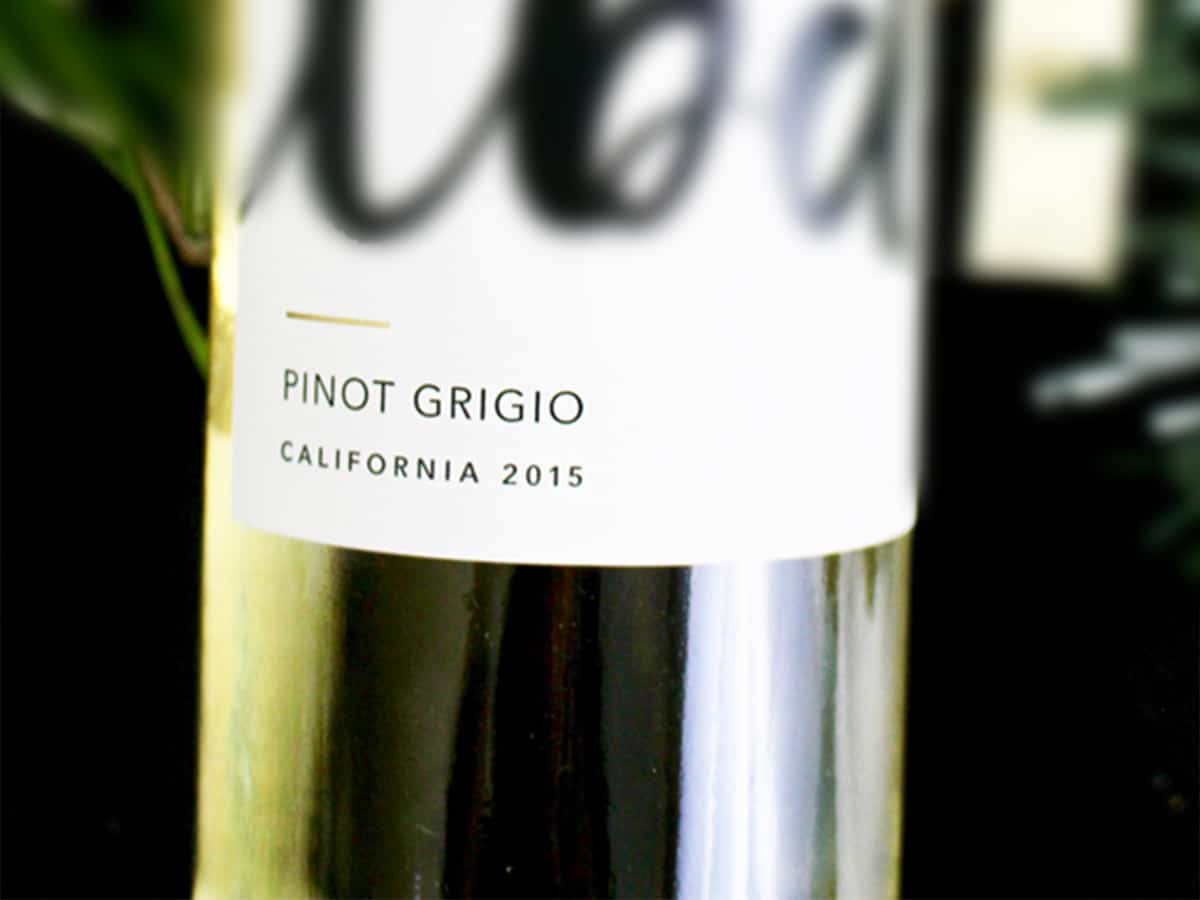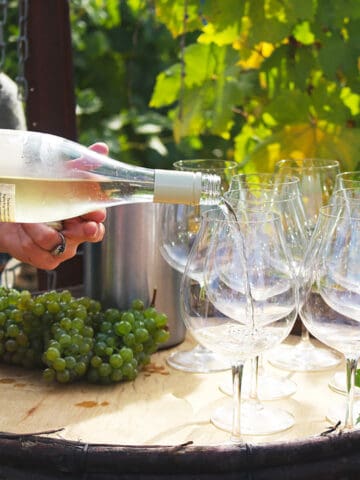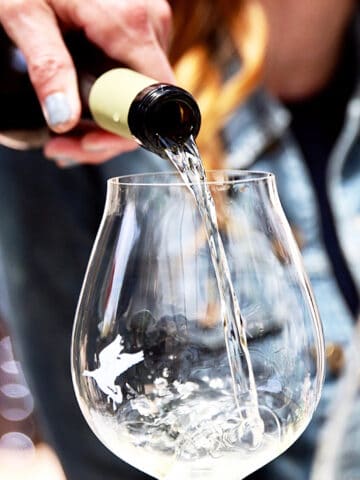Chardonnay is the most widely consumed white wine in the world. And Pinot Grigio isn’t far behind. So what makes them so popular among wine lovers? And what sets them apart? Use this tasting guide to discover the main differences between Chardonnay vs Pinot Grigio.

Both Chardonnay and Pinot Grigio have their roots in France. But today they’re grown and consumed worldwide — and they rank among the most popular white wines. However, they each have distinct characteristics that make them unique.
In this easy-to-follow guide, we’ll review each wine’s flavor profile. Plus, we’ll take a look at ideal food pairings, average prices, and more to help you choose your next bottle with confidence.


Jump to:
- The origin of Pinot Grigio
- The origin of Chardonnay
- Chardonnay flavor characteristics and aroma
- Pinot Grigio flavor characteristics and aroma
- Acidity in Chardonnay and Pinot Grigio
- Chardonnay and Pinot Grigio: Body
- Chardonnay and Pinot Grigio: Color
- Chardonnay and Pinot Grigio food pairings
- Price of Chardonnay and Pinot Grigio
- Chardonnay vs Pinot Grigio summary
- More wine-related answers
The origin of Pinot Grigio
While the Pinot Grigio grape is used to make white wine, it’s actually a mutation of the same grape used to make red Pinot Noir.
It originated in the Burgundy region of France (where it’s called Pinot Gris) and dates back about two thousand years.
Shortly before the Renaissance in the 14th century, the Pinot Grigio grape began to spread from Burgundy, becoming widely planted in neighboring Switzerland and Italy.
These days, most Italian Pinot Grigio grapes are grown in areas including Veneto and Friuli-Venezia Giulia, located in northern Italy.
“Grigio” is the Italian word for gray. And even though Pinot Grigio is a white wine, the grapes used to produce it are actually grayish-pink in color.
Apart from Italy, Pinot Grigio (and Pinot Gris grapes) are also grown in France, the United States, Germany, Australia, and parts of South America.
The origin of Chardonnay
France’s Burgundy region is also home to the Chardonnay grape. And like Pinot Grigio, it also has a close connection to Pinot Noir.
DNA research recently revealed that Chardonnay is actually derived from Pinot Noir and two other grape varieties: Pinot Blanc and Gouais Blanc. Scientists believe the earliest forms of the grape and the wine may have originated during Roman times.
Today, Chardonnay is one of Burgundy’s two dominant grape varieties, along with Pinot Noir. Worldwide, roughly 519,000 acres of Chardonnay vines are planted, making it the most widely grown white wine grape on the planet.
It thrives in both warm and cool climates. In addition to France, Chardonnay is widely produced in parts of Australia, South America, Italy, and the United States – particularly California, Oregon, and Washington state.
Chardonnay flavor characteristics and aroma

The climate in which Chardonnay is grown — and the process used to make the wine — affect its flavor profile in different ways.
Chardonnay grapes grown in warmer regions like central California and South Africa tend to exhibit richer fruity flavors like apple, peach, pineapple, and fig. These also are often aged in oak barrels to enhance the wine’s body and give it additional flavor characteristics.
Chardonnay wines produced in cooler climates such as Europe and other parts of North America, like Oregon, often have more citrus flavors, along with apple, honey, and mineral characteristics. These wines are typically not aged in oak, resulting in dryer, crisper whites.
Oaked vs unoaked Chardonnay
So, what exactly does oaked and unoaked wine mean? In the simplest sense, it indicates how the wines are fermented and stored during the winemaking process.
Oaked refers to wines that are stored in oak barrels for at least part of the process, whether that’s for both fermenting and aging or aging only. The oak barrels can produce a softer, rounder flavor profile, often imparting notes of vanilla and spice and resulting in a full-bodied wine.
As the name implies, unoaked chardonnay does not use oak barrels. Rather, the wine is fermented and aged in stainless steel tanks prior to bottling. This typically produces a crisp, dry white wine with bright flavors and a lighter body.
What produces a buttery Chardonnay?
You may have heard certain Chardonnays referred to as buttery. That can apply to both the taste and the texture. It’s produced through a process called Malolactic Fermentation (MLF).
MLF is a second fermentation that occurs after the initial one. During the process, bacteria convert malic acid in grapes into lactic acid. While malic acid naturally tastes like tart green apples, lactic acid is soft and buttery.
The result is wines that have a creamy, velvety mouthfeel and a slight buttery flavor and aroma.
Pinot Grigio flavor characteristics and aroma

Most Pinot Grigio wines have similar flavor profiles to cooler-climate Chardonnays. Lemon, lime, and orange are common flavor characteristics in this Italian wine, as are honey, green apple, and stone fruit like pear and apricot.
You’ll have hints of these in the aroma as well, along with floral and mineral notes.
Generally a dry wine, Pinot Grigio often matures in stainless steel tanks, which results in a clean, crisp finish. These are widely produced in Italy, as well as in North America and parts of the southern hemisphere, where they’re called Pinot Gris.
Sweeter versions of the wine are mainly made in the Alsace region of France. Honeycomb, sweet apple, and lemon are common flavor notes among these wines. They’re often aged in oak barrels and can evoke spicier notes including cinnamon and ginger.
Acidity in Chardonnay and Pinot Grigio
The acidity levels in Chardonnay often align with the climate in which it is produced. Chardonnays grown in warmer climates tend to have medium to low acidity. The acid in the white wine grapes levels off as higher temperatures allow them to ripen more.
Cool climate Chardonnay tends to have higher levels of acid, as lower temperatures delay ripening and keep natural sugar levels in the grapes low.
Similarly, Pinot Grigio also typically has high acidity, due mainly to the cooler regions in which the grapes are grown. Such white wines tend to be bright and zesty. They coat the sides of your tongue and awaken the mouth when you drink them. And you’ll often detect some zingy tartness.
Chardonnay and Pinot Grigio: Body
Chardonnay
As noted above, the winemaking process can affect the body of Chardonnays. Oaked ones tend to be more fuller-bodied, while unoaked ones are often crisper and lighter.
And because oaked Chardonnays often align with warmer growing regions, they also tend to be higher in alcohol. That’s because as grapes ripen, they produce sugars. The longer they stay on the vine and the more sun they are exposed to, the more sugar they generally will contain. That sugar is then converted to alcohol during the fermentation process.
The alcohol content in warm-climate Chardonnays often reaches as high as 15% ABV. Colder climate ones typically average between 13-13.5% ABV.
Pinot Grigio
Pinot Grigio wines, especially those produced in cooler regions generally have a light body and are crisp and refreshing. And they have somewhat low alcohol levels — usually falling somewhere between 12.5% to 13.5% ABV.
Pinot Gris from Alsace can be significantly sweeter and have a bit more alcohol content, so they can feel heavier.
Chardonnay and Pinot Grigio: Color
The production method often can affect the color of Chardonnay. Unoaked ones are generally pale or light yellow in color. The lighter hue indicates little or no exposure to oak during the fermentation and aging process.
Oaked Chardonnays can be a darker yellow or gold. Often, the richer the yellow, the longer the Chardonnay has been aged in oak. This likely also indicates it has undergone malolactic fermentation and will probably have a creamy and buttery taste and texture.
In most cases, Pinot Grigio will be on the lighter side of the white wine color scale. They’re often pale yellow to light gold or straw in color.
Chardonnay and Pinot Grigio food pairings

Chardonnay
Lighter-bodied, unoaked Chardonnay pairs well with lighter foods like seafood and fresh cheeses. Try it with dishes like Pan Seared Salmon and Pasta with Clams.
White meats and pasta with richer sauces can complement more fuller-bodied Chardonnays. Pair them with dishes like Honey Garlic Chicken Skewers or Mushroom Marsala.
Pinot Grigio
Lighter foods and seafood dishes pair well with Pinot Grigio. These include halibut and flounder, as well as shellfish such as shrimp, mussels, and crab.
White meat such as chicken and pork, as well as brighter cheeses, also pair well with Pinot Grigio. Spring vegetables like peas or even a vegetable risotto could also be an ideal pairing.
Price of Chardonnay and Pinot Grigio
Just as the winemaking process of Chardonnay can vary, so can prices. Though very high-quality Chardonnays can fetch $100 and more, you can often find good bottles for around $25 dollars at most wine shops and supermarkets.
Pinot Grigios are often even more affordable. You can pick up a good one for around $10-$15. Expect to pay only slightly more for higher-quality Pinot Grigios. Many can fall in the $25 range.
Chardonnay vs Pinot Grigio summary
Chardonnay
- Primary growing regions: France, United States, New Zealand, Australia, South Africa, South America
- Worldwide growing acres: 519,000
- Dry
- Body: Medium-light to full
- Color: Pale yellow to rich gold
- Acidity: Low to medium-high depending on climate
- Flavor notes: Citrus, apple, honey, pineapple, peach, and fig, minerals
- Cost: $25+ for ready-to-drink Chardonnay; $50 and up for higher quality
Pinot Grigio
- Primary growing regions: Italy, France, United States, Germany
- Worldwide growing acres: 148,000
- Dry
- Body: Light to medium
- Color: Pale yellow to light gold
- Acidity: Medium to high
- Flavor notes: Lime, lemon, green apple, pear, honey, apricot
- Cost: $10-$15 for ready-to-drink Pinot Grigio; $25 and up for higher quality
More wine-related answers
Learn about the differences between other styles of wine by checking out the posts below.






Leave a Reply